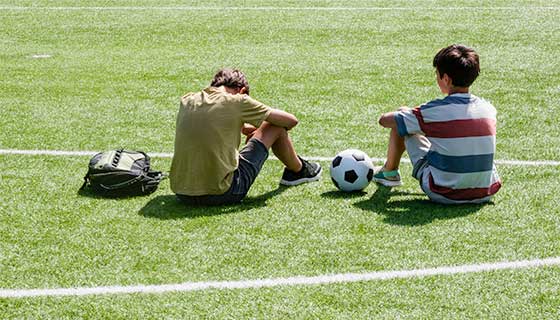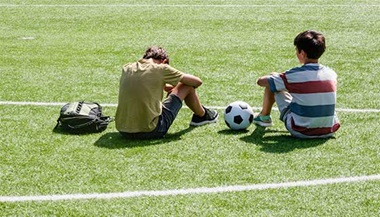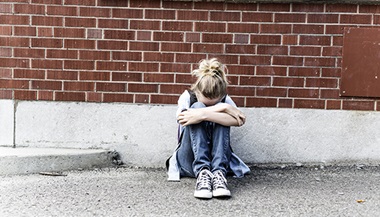7 Tips for Helping Your Child Deal with Bullying
Featured Expert:
Bullying is a serious issue that affects up to 75 percent of kids at some point between kindergarten and 12th grade. Most of those kids will be OK in the end, but 10–20 percent of kids will be chronically bullied and at risk for poor physical and mental health outcomes, such as physical ailments, depression and anxiety, aggression and, in extreme cases, suicide, as well as lower graduation rates and lower career placement.
Chronic bullying has three components: a power differential between the child and the aggressor, repeated bullying day after day, and a social sanctioning aspect where the social structure maintains the victim’s status.
This can be very troubling for parents and caregivers, but there are things you can do to help a child who is a victim or committer of bullying. Melissa Faith, Ph.D., ABPP, a clinical pediatric psychologist and board certified specialist in clinical child and adolescent psychology at Johns Hopkins All Children’s Hospital, offers these tips for families:
Encourage your child to be a friend.
- As a parent, you will know where your child fits into their school’s social structure. For children who have high social status–have a lot of friends, teachers like them, they’re popular and make friends easily–encourage them to stand up for children who are bullied. Let them know that it is OK to say to the aggressor, “That’s not OK," and then take the victim under their wing. If they aren’t comfortable with that, they can always tell a teacher or another trusted adult.
- As children move into their adolescence or older teenage years, very confident children may want to do more. Encourage them to reach out to their friends and to reach out to other children at school.
Create a culture of inclusion.
- Engage in emotion coaching to help build emotional skills. Help your child understand his or her feelings and why other people may feel differently.
- Model pro-social behaviors for your children. Talk through what you’ve done and why you’ve acted that way.
- As a parent, you can reach out to the parents of a friend your child trusts and encourage them to help and have conversations with their child about what it means to leave someone out and what things they can do when they see someone being excluded from activities.
Support extracurricular activity.
- Mastering at least one specialty area can help protect against the long-term negative impacts of chronic bullying. Cooperative, team-based activities also can help foster social skills and provide opportunities for your child to build friendships with other children who have similar interests. Activities can be based in the arts, such as choir, theater or dance, or athletics, such as track or football.
Foster “best friendships.”
- Having at least one best friendship can protect children against the negative effects of chronic bullying. As a parent, you can foster best friendships. Encourage your child to invite a close friend to do things together and help them spend more time with the children important to them.
Get involved in your child’s school.
- In Florida, every school district is required to have a written policy about what they’ll do if there is bullying, what the consequences will be, and how they will offer help.
- If there is a bullying incident, make a request, in writing, to your child’s school counselor and/or principal, respectfully asking for an investigation. After that, schedule a meeting with everyone who might be important in the incident (e.g., the school counselor, your child’s teacher) and ask questions, make specific requests of the school and leave the meeting with a written plan saying exactly what is going to be done. Remember that your child’s teacher could have great strategies that have worked in the classroom in the past, so it can be helpful to pick the teacher’s brain about his or her suggested strategies. Schedule a follow up meeting about a month later.
- Many victims of chronic bullying find that their victim status is very hard to change, in part because other children in the classroom may be afraid to stand up to the bully and/or because other children in the classroom have started to adopt a view that the child is a victim. For these reasons, sometimes the best thing to do is to move the victim into another classroom. Note that moving the bully into another classroom is rarely helpful because chronic bullying is really about the entire social structure in the classroom—not just about the bully and victim.
Find security against cyberbullying.
- Cyberbullying is different from other forms of bullying because it takes place online where the bullies can remain anonymous and parents may not even be aware of what is going on. Kids who are being cyberbullied might not tell parents because they may be afraid of losing access to technology or of consequences if they were on sites they should not have been on.
- As a parent, you can put controls on your computer and other devices that limit what your child can see based on their age.
- Young kids can be instructed that only certain icons on the phone or tablet home screen are OK for them to touch.
- Have discussions with older kids about what your expectations are. Set up social media accounts with them. Know their passwords. Inform your child that you will occasionally login to their social media accounts and, if the child has changed his or her password to prevent parents’ access, the child’s access to social media and/or electronics will be suspended. If necessary, there are tools available that can track what sites your child visits and what they say online.
Don’t be afraid to seek help.
- If your child is a victim of bullying, or if your child is a bully, and the situation has surpassed what you as a parent have the resources to fix, help is available. Talking to a mental health professional can give your family the tools and support to work through difficult situations.






